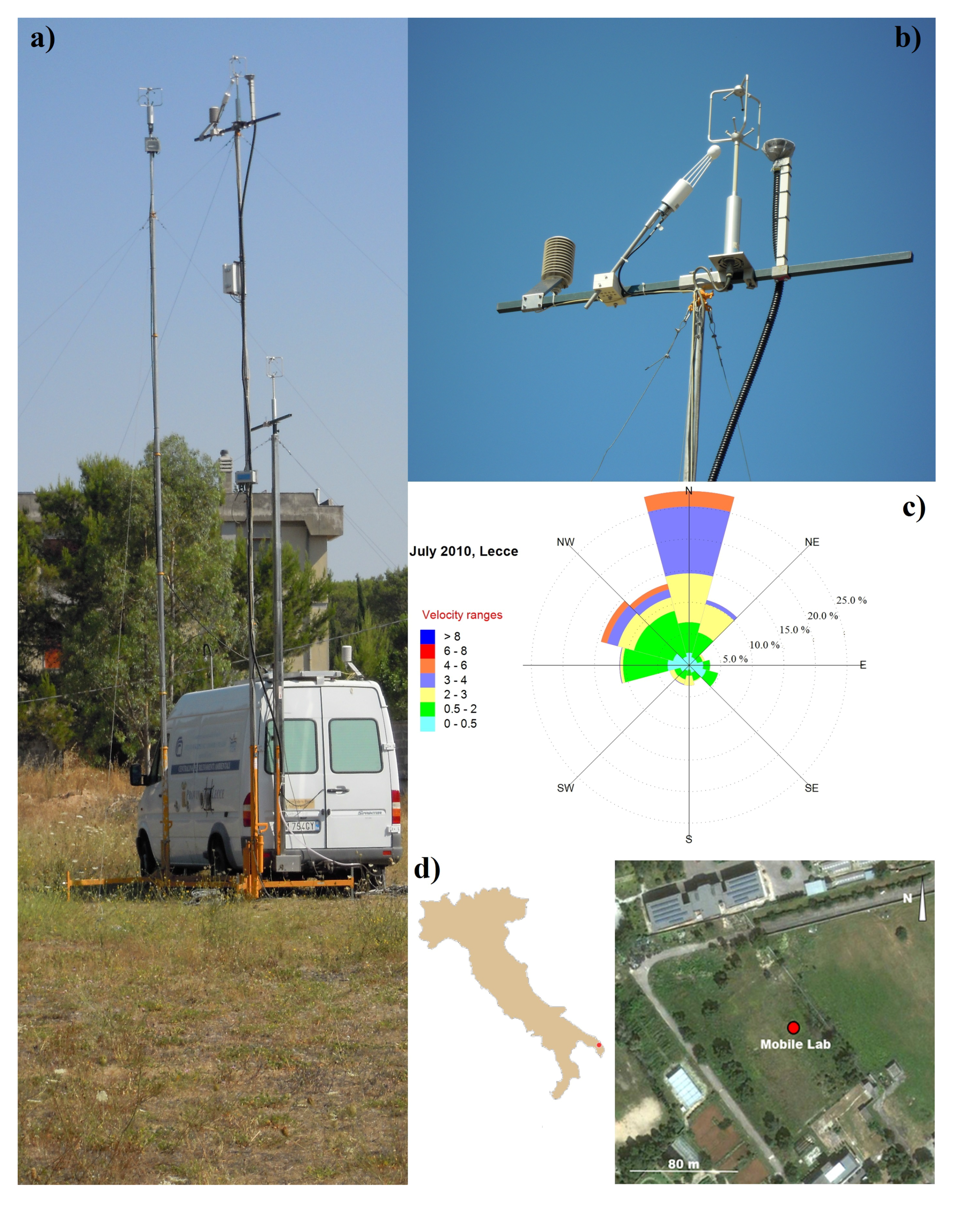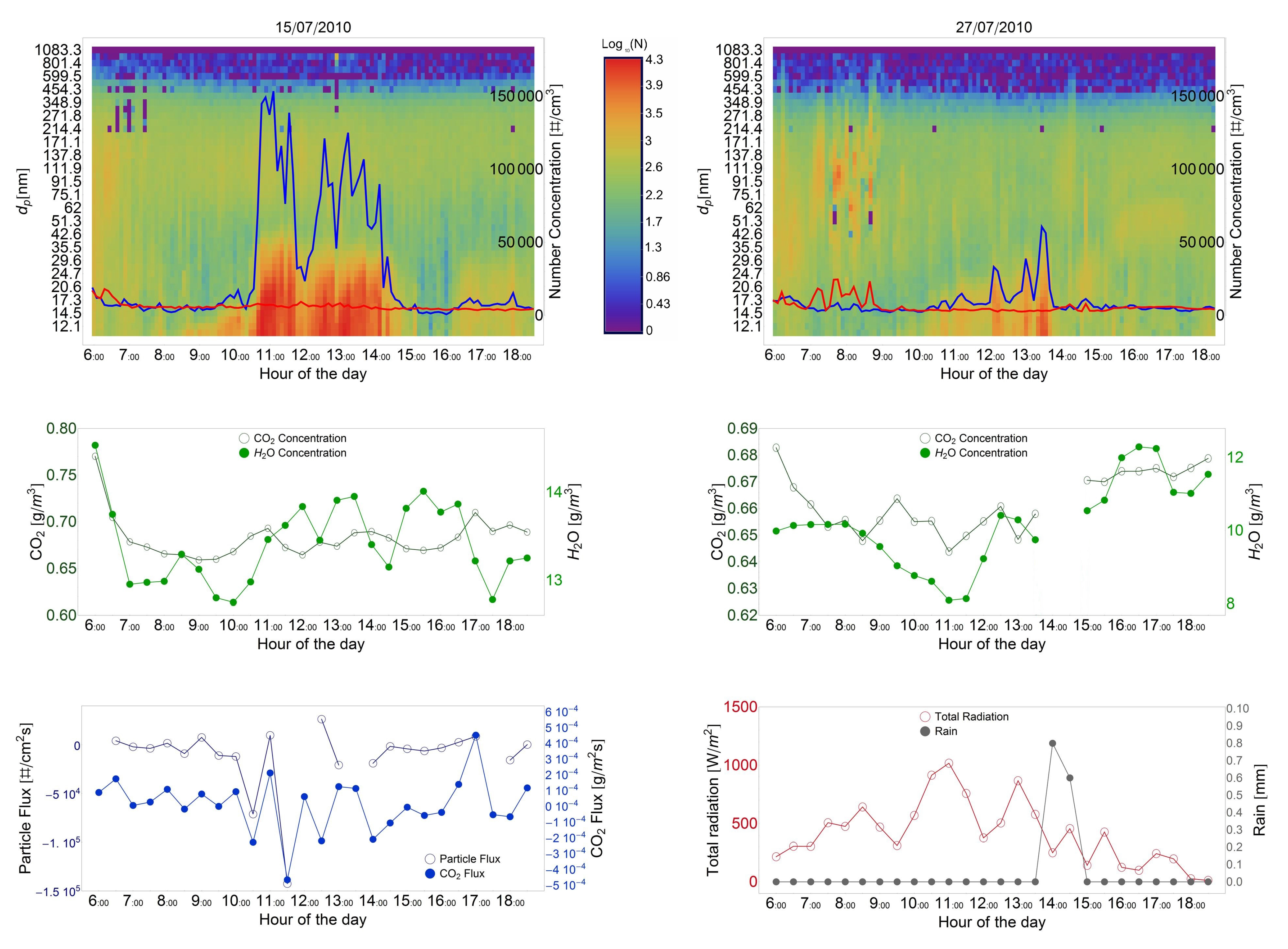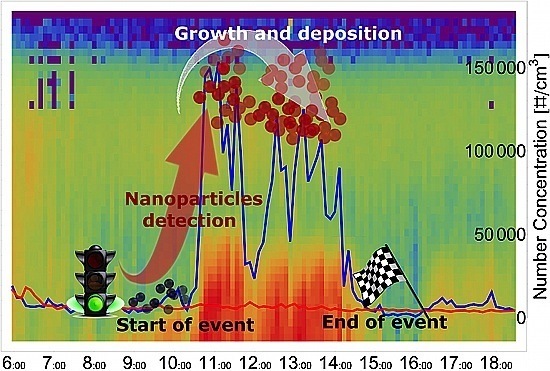Case Study of Particle Number Fluxes and Size Distributions during Nucleation Events in Southeastern Italy in the Summer
Abstract
:1. Introduction
2. Experimental Section
2.1. Site Description
2.2. Instruments Used

2.3. Post-Processing and Data Selection
3. Results and Discussion

3.1. Characterization of Measured Concentrations and Size Distributions

| Solar Radiation | Temperature | Rel.Humidity | Wind Velocity | |
| W/m2 | C° | % | m/s | |
| Nanoparticles | 0.77 | 0.50 | −0.49 | 0.55 |
| Particles Dp > 50 nm | −0.74 | −0.90 | 0.91 | −0.92 |
| CO2 Conc. | u * | H | E | |
| g/m3 | m/s | W/m2 | W/m2 | |
| Nanoparticles | −0.53 | 0.53 | 0.77 | 0.71 |
| Particles Dp > 50 nm | 0.84 | −0.88 | −0.77 | −0.63 |

3.2. Analysis of Specific Nanoparticle Events

3.3. Comparison between Event and Non-Event Days

| Dmean | Dmedian | Number Conc. | CO2 Conc. | Particle Flux | CO2 Flux | |
| nm | nm | #/cm3 | g/m3 | #/cm2 s | 10−5g/m2s | |
| E | 35.4 ± 0.6 | 15.5 ± 0.3 | 27,170 ± 2223 | 0.66 ± 0.001 | −5567 ± 2386 | −2.0 ± 1.8 |
| NE | 62.3 ± 1.2 | 29.1 ± 1.3 | 10,692 ± 734 | 0.65 ± 0.001 | 1231 ± 1314 | −0.65 ± 1.6 |
| Total Radiation | Temperature | H2O Conc. | H | E | U | |
| W/m2 | C° | g/m3 | W/m2s | W/m2s | m/s | |
| E | 702 ± 16 | 30.0 ± 0.3 | 12.4 ± 0.2 | 272 ± 7 | 36 ± 3 | 3.1 ± 0.1 |
| NE | 735 ± 17 | 32.0 ± 0.2 | 12.6 ± 0.3 | 304 ± 8 | 44 ± 3 | 2.6 ± 0.1 |
| TKE | σu | σv | σw | |
| m2/s2 | m/s | m/s | m/s | |
| E | 2.35 ± 0.08 | 1.41 ± 0.03 | 1.37 ± 0.03 | 0.80 ± 0.02 |
| NE | 1.91 ± 0.06 | 1.29 ± 0.03 | 1.21 ± 0.03 | 0.74 ± 0.02 |
4. Conclusions
Acknowledgments
Author Contributions
Conflicts of Interest
References
- Kulmala, M.; Vehkamäki, H.; Petäjä, T.; Dal Maso, M.; Lauri, A.; Kerminem, V.M.W.; Birmili, W.; Mc Murry, P.H. Formation and growth rates of ultrafine atmospheric particles: A review of observations. J. Aerosol Sci. 2004, 35, 143–176. [Google Scholar] [CrossRef]
- Mäkelä, J.M.; Aalto, P.; Jokinen, V.; Pohja, T.; Nissinen, A.; Palmroth, S.; Markkanen, T.; Seitsonen, K.; Lihavainen, H.; Kulmala, M. Observations of ultrafine aerosol particle formation and growth in boreal forest. Geophys. Res. Lett. 1997, 24, 1219–1222. [Google Scholar] [CrossRef]
- Wiedensohler, A.; Covert, D.S.; Swietlicki, E.; Aalto, P.P.; Heintzenberg, J.; Leck, C. Occurrence of an ultrafine particle mode less than 20 nm in diameter in the marine boundary layer during Arctic summer and autumn. Tellus 1996, 48, 213–222. [Google Scholar] [CrossRef]
- Stanier, C.O.; Khlystov, A.Y.; Pandis, S.N. Nucleation events during the Pittsburgh air quality study: Description and relation to key meteorological, gas phase, and aerosol parameters. Aerosol Sci. Technol. 2004, 38, 253–264. [Google Scholar] [CrossRef]
- Kulmala, M.; Petäjä, T.; Mönkkönen, P.; Koponen, I.K.; Dal Maso, M.; Aalto, P.P.; Lehtinen, K.E.J.; Kerminen, V.M. On the growth of nucleation mode particles: Source rates of condensable vapor in polluted and clean environments. Atmos. Chem. Phys. 2005, 5, 409–416. [Google Scholar] [CrossRef]
- Petäjä, T.; Kerminem, V.M.W.; Dal Maso, M.; Junninen, H.; Koponen, I.K.; Hussein, T.; Alto, P.P.; Andronopoulos, S.; Robin, D.; Hämeri, K.; et al. Sub-micron atmospheric aerosols in the surroundings of Marseille and Athens: Physical characterization and new particle formation. Atmos. Chem. Phys. 2007, 7, 2705–2720. [Google Scholar] [CrossRef]
- Pillai, P.; Khlystov, A.; Walker, J.; Aneja, V. Observation and analysis of particle nucleation at a forest site in Southeastern U.S. Atmosphere 2013, 4, 72–93. [Google Scholar] [CrossRef]
- Hamed, A.; Joutsensaari, J.; Mikkonen, S.; Sogacheva, L.; Dal Maso, M.; Kulmala, M.; Cavalli, F.; Fuzzi, S.; Facchini, M.C.; Decesari, S.; et al. Nucleation and growth of new particles in Po Valley, Italy. Atmos. Chem. Phys. 2007, 7, 355–376. [Google Scholar] [CrossRef]
- O’Dowd, C.D.; Hämeri, K.; Mäkelä, J.M.; Pirjola, L.; Kulmala, M.; Jennings, S.G.; Berresheim, H.; Hansson, H.-C.; de Leeuw, G.; Kunz, G.J.; et al. A dedicated study of New Particle Formation and Fate in the Coastal Environment (PARFORCE): Overview of objectives and achievements. J. Geophys. Res. 2002, 107. [Google Scholar] [CrossRef]
- De Leeuw, G.; Kunz, G.J.; Buzorius, G.; O’Dowd, C. Meteorlogical influences on coastal new particle formation. J. Geophys. Res. Atmos. 2002, 107. [Google Scholar] [CrossRef]
- McMurry, P.H.; Fink, M.; Sakurai, H.; Stolzenburg, M.R.; Mauldin, R.L., III; Smith, J.; Eisele, F.; Moore, K.; Sjostedt, S.; Tanner, D.; et al. A criterion for new particle formation in the sulfur-rich Atlanta atmosphere. J. Geophys. Res. Atmos. 2005, 110. [Google Scholar] [CrossRef]
- Boy, M.; Kulmala, M. Nucleation events in the continental boundary layer: Influence of physical and meteorological parameters. Atmos. Chem. Phys. 2002, 2, 1–16. [Google Scholar] [CrossRef]
- Jaatinen, A.; Hamed, A.; Joutsensaari, J.; Mikkonen, S.; Birmili, W.; Wehner, B.; Spindler, G.; Wiedensohler, A.; Decesari, S.; Mircea, M.; et al. A comparison of new particle formation events in the boundary layer at three different sites in Europe. Boreal Environ. Res. 2009, 14, 481–498. [Google Scholar]
- Qian, S.; Sakurai, H.; McMurry, P.H. Characteristics of regional nucleation events in urban East St. Louis. Atmos. Environ. 2007, 41, 4119–4127. [Google Scholar] [CrossRef]
- Clement, C.F.; Pirjola, L.; Dal Maso, M.; Mäkela, J.M.; Kulmala, M. Analysis of particle formation bursts observed in Finland. J. Aerosol Sci. 2001, 32, 217–236. [Google Scholar] [CrossRef]
- Hussein, T.; Martikainen, J.; Junninen, H.; Sogacheva, L.; Wagner, R.; Dal Maso, M.; Riipinen, I.; Aalto, P.P.; Kulmala, M. Observation of regional new particle formation in the urban atmosphere. Tellus 2008, 60, 509–521. [Google Scholar] [CrossRef]
- Nilsson, E.D.; Rannik, Ü.; Buzorius, G.; Kulmala, M.; O’Dowd, C. Effects of the continental boundary layer evolution, convection, turbulence and entrainment on aerosol formation. Tellus 2001, 53, 441–461. [Google Scholar] [CrossRef]
- Buzorius, G.; Rannik, Ü.; Nilsson, D.; Kulmala, M. Vertical fluxes and micrometeorology during aerosol particle formation events. Tellus 2001, 53, 394–405. [Google Scholar] [CrossRef]
- Flanagan, R.J.; Geever, M.; O’Dowd, C. Direct measurements of new-particle fluxes in the coastal environment. Environ. Chem. 2005, 2, 256–259. [Google Scholar] [CrossRef]
- Held, A.; Klemm, O. Direct measurement of turbulent particle exchange with a 558 twin CPC eddy covariance system. Atmos. Environ. 2006, 40, S92–S102. [Google Scholar] [CrossRef]
- Ruuskanen, T.M.; Kaasik, M.; Aalto, P.P.; Hõrrak, U.; Vana, M.; Mårtensson, M.; Yoon, Y.J.; Keronen, P.; Mordas, G.; Ceburnis, D.; et al. Concentrations and fluxes of aerosol particles during the LAPBIAT measurement campaign at Värriö field station. Atmos. Chem. Phys. 2007, 7, 3683–3700. [Google Scholar] [CrossRef]
- Donateo, A.; Contini, D. Correlation of dry deposition velocity and friction velocity over different surfaces for PM2.5 and particle number concentrations. Adv. Meteorol. 2014. [Google Scholar] [CrossRef]
- Contini, D.; Donateo, A.; Elefante, C.; Grasso, F.M. Analysis of particles and carbon dioxide concentrations and fluxes in an urban area: Correlation with traffic rate and local micrometeorology. Atmos. Environ. 2012, 46, 25–35. [Google Scholar] [CrossRef]
- Hinds, W.C. Aerosol Technology: Properties, Behaviour, and Measurement of Airborne Particles, 2nd ed.; John Wiley & Sons: Los Angeles, CA, USA, 1999; pp. 8–10. [Google Scholar]
- Heim, M.; Kasper, G.; Reischl, G.P.; Gerhart, C. Performance of a new commercial electrical mobility spectrometer. Aerosol Sci. Technol. 2004, 32, 3–14. [Google Scholar] [CrossRef]
- McMillen, R.T. An eddy-correlation technique with extended applicability to non-simple terrain. Bound. Layer Meteorol. 1988, 43, 231–245. [Google Scholar] [CrossRef]
- Kaimal, J.C.; Finnigan, J.J. Atmospheric Boundary Layer Flows: Their Structure and Measurement; Oxford University Press: New York, NY, USA, 1994; pp. 33–39. [Google Scholar]
- Buzorius, G.; Rannik, U.; Makela, J.M.; Vesala, T.; Kulmala, M. Vertical aerosol particle fluxes measured by eddy covariance technique using condensational particle counter. J. Aerosol Sci. 1998, 29, 157–171. [Google Scholar] [CrossRef]
- Rannik, U.; Vesala, T. Autoregressive filtering versus linear detrending in estimation of fluxes by the eddy covariance method. Bound. Layer Meteorol. 1999, 91, 259–280. [Google Scholar] [CrossRef]
- Businger, J.A. Evaluation of the accuracy with which dry deposition can be measured with current micrometeorological techniques. J. Clim. Appl. Meteorol. 1986, 25, 1100–1124. [Google Scholar] [CrossRef]
- Mahrt, L. Flux sampling errors for aircraft and towers. J. Atmos. Ocean. Technol. 1998, 15, 416–429. [Google Scholar] [CrossRef]
- Cava, D.; Contini, D.; Donateo, A.; Martano, P. Analysis of short-term closure of the surface energy balance above short vegetation. Agric. For. Meteorol. 2008, 148, 82–93. [Google Scholar] [CrossRef]
- Cava, D.; Donateo, A.; Contini, D. Combined stationarity index for the estimation of turbulent fluxes of scalars and particles in the atmospheric surface layer. Agric. For. Meteorol. 2014, 194, 88–103. [Google Scholar] [CrossRef]
- Webb, E.K.; Pearman, G.I.; Leuning, R. Correction of flux measurements for density effects due to heat and water vapour transfer. Q. J. R. Meteorol. Soc. 1980, 106, 85–100. [Google Scholar] [CrossRef]
- Buzorius, G.; Rannik, U.; Makela, J.M.; Keronen, P.; Vesala, T.; Kulmala, M. Vertical aerosol fluxes measured by the eddy covariance method and deposition of nucleation mode particles above a Scots pine forest in southern Finland. J. Geophys. Res. Atmos. 2000, 105, 19905–19916. [Google Scholar] [CrossRef]
- Horst, T.W. A simple formula for attenuation of eddy fluxes measured with first-order response scalar sensors. Bound. Layer Meteorol. 1997, 82, 219–233. [Google Scholar] [CrossRef]
- Contini, D.; Donateo, A.; Belosi, F.; Grasso, F.M.; Santachiara, G.; Prodi, F. Deposition velocity of ultrafine particles measured with eddy-correlation method over Nanseen Ice Sheet (Antarctica). J. Geophys. Res. Atmos. 2010, 115, D16202. [Google Scholar] [CrossRef]
- Fairall, C.W. Interpretation of eddy correlation measurements of particulate deposition and aerosol flux. Atmos. Environ. 1984, 18, 1329–1337. [Google Scholar] [CrossRef]
- Hameri, K.; kumala, M.; Aalto, P.; Leszczynski, K.; Visuri, R.; Hamekoski, K. The investigations of aerosol particle formation in urban background area of Helsinki. Atmos. Res. 1996, 41, 281–298. [Google Scholar] [CrossRef]
- Weber, R.J.; McMurry, P.H.; Mauldin, R.L.; Tanner, D.J.; Eisele, F. L.; Clarke, A.D.; Kapustin, V. New particle formation in the remote troposphere: A comparison of observations at various sites. Geophys. Res. Lett. 1999, 26, 307–310. [Google Scholar] [CrossRef]
- Putaud, J.P.; van Dingenen, R.; Alastuey, A.; Bauer, H.; Birmili, W.; Cyrys, J.; Flentje, H.; Fuzzi, S.; Gehrig, R.; Hansson, H.C.; et al. A European aerosol phenomenology—3: Physical and chemical characteristics of particulate matter from 60 rural, urban and kerbside sites across Europe. Atmos. Environ. 2010, 44, 1308–1320. [Google Scholar] [CrossRef]
- Deshmukh, D.K.; Deb, M.K.; Mkoma, S.L. Size distribution and seasonal variation of size-segregated particulate matter in the ambient air of Raipur city, India. Air Qual. Atmos. Health 2013, 6, 259–276. [Google Scholar] [CrossRef]
- Morawska, L.; Bofinger, N.D.; Kocis, L.; Nwankwoala, A. Submicrometer and supermicrometer particles from diesel vehicle emissions. Environ. Sci. Technol. 1998, 32, 2033–2042. [Google Scholar] [CrossRef]
- Petroff, A.; Zhang, L. Development and validation of a size-resolved particle dry deposition scheme for application in aerosol transport models. Geosci. Model Dev. 2010, 3, 753–769. [Google Scholar] [CrossRef]
© 2015 by the authors; licensee MDPI, Basel, Switzerland. This article is an open access article distributed under the terms and conditions of the Creative Commons Attribution license (http://creativecommons.org/licenses/by/4.0/).
Share and Cite
Conte, M.; Donateo, A.; Dinoi, A.; Belosi, F.; Contini, D. Case Study of Particle Number Fluxes and Size Distributions during Nucleation Events in Southeastern Italy in the Summer. Atmosphere 2015, 6, 942-959. https://doi.org/10.3390/atmos6070942
Conte M, Donateo A, Dinoi A, Belosi F, Contini D. Case Study of Particle Number Fluxes and Size Distributions during Nucleation Events in Southeastern Italy in the Summer. Atmosphere. 2015; 6(7):942-959. https://doi.org/10.3390/atmos6070942
Chicago/Turabian StyleConte, Marianna, Antonio Donateo, Adelaide Dinoi, Franco Belosi, and Daniele Contini. 2015. "Case Study of Particle Number Fluxes and Size Distributions during Nucleation Events in Southeastern Italy in the Summer" Atmosphere 6, no. 7: 942-959. https://doi.org/10.3390/atmos6070942
APA StyleConte, M., Donateo, A., Dinoi, A., Belosi, F., & Contini, D. (2015). Case Study of Particle Number Fluxes and Size Distributions during Nucleation Events in Southeastern Italy in the Summer. Atmosphere, 6(7), 942-959. https://doi.org/10.3390/atmos6070942










